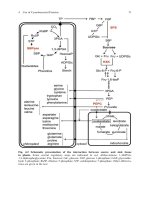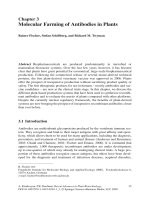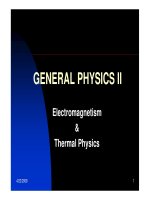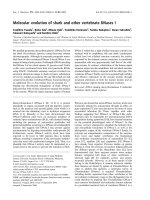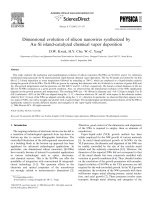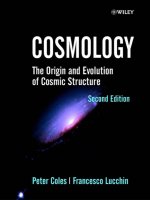directed molecular evolution of proteins
Bạn đang xem bản rút gọn của tài liệu. Xem và tải ngay bản đầy đủ của tài liệu tại đây (6.48 MB, 360 trang )
safecover (100x141x16M jpeg)
Directed Molecular Evolution of Proteins
Edited by S. Brakmann and K. Johnsson
Directed Molecular Evolution of Proteins:orHow to Improve Enzymes for Biocatalysis.
Edited by Susanne Brakmann and Kai Johnsson
Copyright ã 2002 Wiley-VCH Verlag GmbH & Co. KGaA
ISBNs: 3-527-30423-1 (Hardback); 3-527-60064-7 (Electronic)
Related Titles from Wiley-VCH
Kellner,R.; Lottspeich, F.; Meyer, H. E.
Microcharacterization of Proteins
1999
ISBN 3-527-30084-8
Bannwarth,W.; Felder, E.; Mannhold, R.; Kubinyi, H.; Timmermann, H.
Combinatorial Chemistry. A Practical Approach
2000
ISBN 3-527-30186-0
Gualtieri,F.; Mannhold, R.; Kubinyi, H.; Timmermann, H.
New Trends in Synthetic Medicinal Chemistry
2001
ISBN 3-527-29799-5
Clark,D. E.; Mannhold, R.; Kubinyi, H.; Timmermann, H.
Evolutionary Algorithms in Molecular Design
2000
ISBN 3-527-30155-0
Directed Molecular Evolution of Proteins
or How to Improve Enzymes for Biocatalysis
Edited by
Susanne Brakmann and Kai Johnsson
The Editor of this volume
Dr. Susanne Brakmann
AG ¹Angewandte Molekulare Evolutionª
Institut fuÈr Spezielle Zoologie
UniversitaÈt Leipzig
Talstraûe 33
04103 Leipzig, Germany
Prof. Dr. Kai Johnsson
Institute of Molecular
and Biological Chemistry
Swiss Federal Institute of
Technology Lausanne
CH-1015 Lausanne, Switzerland
Cover Illustration Recent advances in automation
and robotics have greatly facilitated the high ±
throughput screening for proteins with desired
functions. Among other devices liquid handling
tools are integral parts of most screening robots.
Depicted are 96-channel pipettors for the microliter-
and submicroliter range (illustrations kindly
provided by Cybio AG, Jena).
This book was carefully produced. Nevertheless,
editors, authors and publisher do not warrant the
information contained therein to be free of errors.
Readers are advised to keep in mind that state-
ments, data, illustrations, procedural details
or other items may inadvertently be inaccurate.
Library of Congress Card No.:
applied for
British Library Cataloguing-in-Publication Data
A catalogue record for this book is available from
the British Library.
Die Deutsche Bibliothek ± CIP Cataloguing-in-Pub-
lication Data
A catalogue record for this publication is available
from Die Deutsche Bibliothek.
ã Wiley-VCH Verlag GmbH, Weinheim 2002
All rights reserved (including those of translation
in other languages). No part of this book may be
reproduced in any form ± by photoprinting, mi-
crofilm, or any other means ± nor transmitted or
translated into machine language without written
permission from the publishers.
In this publication, even without specific indi-
cation, use of registered names, trademarks, etc.,
and reference to patents or utility models does not
imply that such names or any such information are
exempt from the relevant protective laws and reg-
ulations and, therefore, free for general use, nor
does mention of suppliers or of particular com-
mercial products constitute endorsement or
recommendation for use.
Printed on acid-free paper.
Printed in the Federal Republic of Germany.
Composition Mitterweger & Partner
Kommunikationsgesellschaft mbH, Plankstadt
Printing betz-druck GmbH, Darmstadt
Bookbinding Groûbuchbinderei J. SchaÈffer
GmbH & Co. KG, GruÈnstadt
ISBN 3-527-30423-1
Contents
List of Contributors XI
1 Introduction 1
2Evolutionary Biotechnology ± From Ideas and Concepts
to Experiments and Computer Simulations
5
2.1 Evolution in vivo ± From Natural Selection to Population Genetics 5
2.2 Evolution in vitro ± From Kinetic Equations to Magic Molecules 8
2.3 Evolution in silico ± From Neutral Networks to Multi-stable Molecules 16
2.4 Sequence Structure Mappings of Proteins 25
2.5 Concluding Remarks 26
3 Using Evolutionary Strategies to Investigate the Structure
and Function of Chorismate Mutases
29
3.1 Introduction 29
3.2 Selection versus Screening 30
3.2.1 Classical solutions to the sorting problem 31
3.2.2 Advantages and limitations of selection 32
3.3 Genetic Selection of Novel Chorismate Mutases 33
3.3.1 The selection system 35
3.3.2 Mechanistic studies 37
3.3.2.1 Active site residues 37
3.3.2.2 Random protein truncation 42
3.3.3 Structural studies 44
3.3.3.1 Constraints on interhelical loops 44
3.3.4 Altering protein topology 46
3.3.4.1 New quaternary structures 47
3.3.4.2 Stable monomeric mutases 49
3.3.5 Augmenting weak enzyme activity 51
3.3.6 Protein design 53
3.4 Summary and General Perspectives 57
Directed Molecular Evolution of Proteins:orHow to Improve Enzymes for Biocatalysis.
Edited by Susanne Brakmann and Kai Johnsson
Copyright ã 2002 Wiley-VCH Verlag GmbH & Co. KGaA
ISBNs: 3-527-30423-1 (Hardback); 3-527-60064-7 (Electronic)
4Construction of Environmental Libraries for Functional Screening
of Enzyme Activity
63
4.1 Sample Collection and DNA Isolation from Environmental Samples 65
4.2 Construction of Environmental Libraries 68
4.3 Screening of Environmental Libraries 71
4.4 Conclusions 76
5 Investigation of Phage Display for the Directed Evolution of Enzymes 79
5.1 Introduction 79
5.2 The Phage Display 79
5.3 Phage Display of Enzymes 81
5.3.1 The expression vectors 81
5.3.1.1 Filamentous bacteriophages 81
5.3.1.2 Other phages 83
5.3.2 Phage-enzymes 84
5.4 Creating Libraries of Mutants 87
5.5 Selection of Phage-enzymes 89
5.5.1 Selection for binding 89
5.5.2 Selection for catalytic activity 90
5.5.2.1 Selection with substrate or product analogues 90
5.5.2.2 Selection with transition-state analogues 92
5.5.2.3 Selection of reactive active site residues by affinity labeling 96
5.5.2.4 Selection with suicide substrates 98
5.5.2.5 Selections based directly on substrate transformations 102
5.6 Conclusions 108
6 Directed Evolution of Binding Proteins by Cell Surface Display: Analysis
of the Screening Process
111
6.1 Introduction 111
6.2 Library Construction 113
6.2.1 Mutagenesis 113
6.2.2 Expression 114
6.3 Mutant Isolation 115
6.3.1 Differential labeling 115
6.3.2 Screening 119
6.4 Summary 124
Acknowledgments 124
7Yeast n-Hybrid Systems for Molecular Evolution 127
7.1 Introduction 127
7.2 Technical Considerations 130
7.2.1 Yeast two-hybrid assay 130
7.2.2 Alternative assays 141
7.3 Applications 147
7.3.1 Protein-protein interactions 147
7.3.2 Protein-DNA interactions 149
ContentsVI
7.3.3 Protein-RNA interactions 150
7.3.4 Protein-small molecule interactions 153
7.4 Conclusion 155
8 Advanced Screening Strategies for Biocatalyst Discovery 159
8.1 Introduction 159
8.2 Semi-quantitative Screening in Agar-plate Formats 161
8.3 Solution-based Screening in Microplate Formats 164
8.4 Robotics and Automation 169
9 Engineering Protein Evolution 177
9.1 Introduction 177
9.2 Mechanisms of Protein Evolution in Nature 178
9.2.1 Gene duplication 179
9.2.2 Tandem duplication 180
ba-barrels 181
9.2.3 Circular permutation 182
9.2.4 Oligomerization 183
9.2.5 Gene fusion 184
9.2.6 Domain recruitment 184
9.2.7 Exon shuffling 186
9.3 Engineering Genes and Gene Fragments 187
9.3.1 Protein fragmentation 188
9.3.2 Rational swapping of secondary structure elements and domains 189
9.3.3 Combinatorial gene fragment shuffling 190
9.3.4 Modular recombination and protein folding 194
9.3.5 Rational domain assembly ± engineering zinc fingers 199
9.3.6 Combinatorial domain recombination ± exon shuffling 200
9.4 Gene Fusion ± From Bi- to Multifunctional Enzymes 203
9.4.1 End-to-end gene fusions 203
9.4.2 Gene insertions 203
9.4.3 Modular design in multifunctional enzymes 204
9.5 Perspectives 208
10 Exploring the Diversity of Heme Enzymes through Directed Evolution 215
10.1 Introduction 215
10.2 Heme Proteins 216
10.3 Cytochromes P450 218
10.3.1 Introduction 218
10.3.1 Mechanism 220
10.3.2.1 The catalytic cycle 220
10.3.2.2 Uncoupling 222
10.3.2.3 Peroxide shunt pathway 222
10.4 Peroxidases 223
10.4.1 Introduction 223
10.4.2 Mechanism 223
VII
10.4.2.1 Compound I formation 223
10.4.2.2 Oxidative dehydrogenation 226
10.4.2.3 Oxidative halogenation 226
10.4.2.4 Peroxide disproportionation 226
10.4.2.5 Oxygen transfer 227
10.5 Comparison of P450s and Peroxidases 227
10.6 Chloroperoxidase 228
10.7 Mutagenesis Studies 229
10.7.1 P450s 230
10.7.1.1 P450
cam
230
10.7.1.2 Eukaryotic P450s 230
10.7.2 HRP 231
10.7.3 CPO 231
10.7.4 Myoglobin (Mb) 232
10.8 Directed Evolution of Heme Enzymes 233
10.8.1 P450s 233
10.8.2 Peroxidases 234
10.8.3 CPO 236
10.8.4 Catalase I 236
10.8.5 Myoglobin 237
10.8.6 Methods for recombination of P450s 237
10.9 Conclusions 238
11 Directed Evolution as a Means to Create Enantioselective Enzymes for Use
in Organic Chemistry
245
11.1 Introduction 245
11.2 Mutagenesis Methods 247
11.3 Overexpression of Genes and Secretion of Enzymes 248
11.4 High-Throughput Screening Systems for Enantioselectivity 250
11.5 Examples of Directed Evolution of Enantioselective Enzymes 257
11.5.1 Kinetic resolution of a chiral ester catalyzed by mutant lipases 257
11.5.2 Evolution of a lipase for the stereoselective hydrolysis of a
meso-compound
268
11.5.3 Kinetic resolution of a chiral ester catalyzed by a mutant esterase 269
11.5.4 Improving the enantioselectivity of a transaminase 270
11.5.5 Inversion of the enantioselectivity of a hydantoinase 270
11.5.6 Evolving aldolases which accept both D- and L-glyceraldehydes 271
11.6 Conclusions 273
12 Applied Molecular Evolution of Enzymes Involved in Synthesis and Repair
of DNA
281
12.1 Introduction 281
12.2 Directed Evolution of Enzymes 282
12.2.1 Site-directed mutagenesis 283
12.2.2 Directed evolution 284
ContentsVIII
12.2.3 Genetic damage 285
12.2.4 PCR mutagenesis 286
12.2.5 DNA shuffling 287
12.2.6 Substitution by oligonucleotides containing random mutations
(random mutagenesis)
288
12.3 Directed Evolution of DNA polymerases 289
12.3.1 Random mutagenesis of Thermus aquaticus DNA Pol I 291
12.3.1.1 Determination of structural components for Taq DNA polymerase
fidelity
292
12.3.1.2 Directed evolution of a RNA polymerase from Taq DNA polymerase 293
12.3.1.3 Mutability of the Taq polymerase active site 294
12.3.2 Random oligonucleotide mutagenesis of Escherichia coli Pol I 294
12.4 Directed Evolution of Thymidine Kinase 295
12.5 Directed Evolution of Thymidylate Synthase 297
12.6 O
6
-Alkylguanine-DNA Alkyltransferase 300
12.7 Discussion 302
13 Evolutionary Generation versus Rational Design of Restriction Endonucleases
with Novel Specificity
309
13.1 Introduction 309
13.1.1 Biology of restriction/modification systems 309
13.1.2 Biochemical properties of type II restriction endonucleases 310
13.1.3 Applications for type II restriction endonucleases 311
13.1.4 Setting the stage for protein engineering of type II restriction
endonucleases
313
13.2 Design of Restriction Endonucleases with New Specificities 313
13.2.1 Rational design 313
13.2.1.1 Attempts to employ rational design to change the specificity
of restriction enzymes
313
14.2.1.1 Changing the substrate specificity of type IIs restriction enzymes
by domain fusion
316
13.2.1.3 Rational design to extend specificities of type II restriction enzymes 316
13.2.2 Evolutionary design of extended specificities 318
13.3 Summary and Outlook 324
14 Evolutionary Generation of Enzymes with Novel Substrate Specificities 329
14.1 Introduction 329
14.2 General Considerations 331
14.3 Examples 333
14.3.1 Group 1 333
14.3.2 Group 2 337
14.3.3 Group 3 338
14.4 Conclusions 339
Index 343
IX
1
Introduction
Kai Johnsson, and Susanne Brakmann
The application of evolutionary and combinatorial techniques to study and solve com-
plex biological and chemical problems has become one of the most dynamic fields in
chemistry and biology. The book presented here is a loose collection of articles aiming
to provide an overview of the current state of the art of the directed evolution of pro-
teins as well as highlighting the challenges and possibilities in the field that lie ahead.
Although the first examples of directed molecular evolution date back to the pioneer-
ing experiments of S. Spiegelman et al. and of M. Eigen and W. Gardiner, who pro-
posed that evolutionary approaches be adapted for the engineering of biomolecules [1,
2], it was the success of methods such as phage display for in vitro selection of peptides
and proteins as well the selection of functional nucleic acids using the SELEX proce-
dure (Systematic Evolution of Ligands by Exponential enrichment) that brought the
power of this concept to the attention of the general scientific community [3, 4]. In
the last decade, directed evolution has become a key technology for biomolecule en-
gineering. The success of the evolutionary approach, however, not only depends on
the potency of the method itself but is also a result of the limitations of alternative
approaches, as our lack of understanding of the structure-function relationship of
proteins in general hinders the rational design of biomolecules with new func-
tions. What are the prerequisites for a successful directed evolution experiment?
In its broadest sense, (directed) evolution can be considered as repeated cycles of var-
iation followed by selection. In the first chapter of the book, the underlying principles
of this concept and their application to the evolutionary design of biomolecules are
reviewed by P. Schuster ± one of the pioneers in the field of molecular evolution.
Naturally, the first step of each evolutionary project is the creation of diversity. The
most straightforward approach to create a library of proteins is to introduce random
mutations into the gene of interest by techniques such as error-prone PCR or satura-
tion mutagenesis. The success of random mutagenesis strategies is witnessed by their
ample appearances in the different chapters of this book describing case studies of
particular classes of proteins and enzymes. In addition, recombination of mutant
Directed Molecular Evolution of Proteins:orHow to Improve Enzymes for Biocatalysis.
Edited by Susanne Brakmann and Kai Johnsson
Copyright ã 2002 Wiley-VCH Verlag GmbH & Co. KGaA
ISBNs: 3-527-30423-1 (Hardback); 3-527-60064-7 (Electronic)
genes by DNA shuffling or related techniques can be used to create additional diversity
and to accumulate rapidly beneficial and additive point mutations [5]. This is a key
technique that also surfaces in the majority of the chapters. The sequence space
searched by these approaches is, however, quite limited. DNA shuffling between
homologous genes, which has also been called family shuffling, allows yet unexplored
regions of sequence space to be accessed [6]. In the chapter by S. Lutz and S. J. Ben-
kovic, an approach to create chimeras even between non-homologous genes and its
application in protein engineering is described.
An interesting alternative to the generation of libraries with in vitro methods is the
generation of so-called environmental libraries, described by R. Daniel. Here, advan-
tage is taken of natural microbial diversity by isolating and cloning environmental
DNA and by using the resulting libraries to search for novel biocatalysts.
After the creation of diversity, i.e. the generation of a library of different mutants, the
protein(s) with the desired phenotype (function or activity) have to be selected from the
library. This can be achieved by either selection or screening procedures. The principal
advantage of selection is that much larger libraries can be examined: the number of
clones that can be subjected to selection is, in general, five orders of magnitudes above
those that can be sorted by advanced screening methods. Impressive examples for the
power of true selection, where the survival of the host is directly coupled to the desired
phenotype, can be found in the chapters written by D. Hilvert et al. and J. F. Davidson et
al The major challenge of most selection approaches is to couple the desired pheno-
type, such as the catalysis of an industrially important reaction, to the survival of the
host. But what can be done if the desired phenotype cannot provide a direct selective
advantage to a given host organism? Different approaches appear feasible: if the de-
sired property binds to a given molecule, display systems for the protein of interest
such as phage display, ribosomal display or mRNA display, and the subsequent in vitro
selection of binders by so-called panning procedures are established technologies [3, 7,
8]. A recent publication by the group of J. W. Szostak describes the employment of in
vitro selection of functional proteins from libraries of completely randomized 80mers
(actual library size 10
13
) using mRNA display. This work highlights the power of in
vitro selection, and is a striking example of an experiment that would simply be im-
possible to perform using screening procedures [9]. In the chapter written by P. Sou-
million and J. Fastrez, an interesting extension of this approach, the in vitro selection of
novel enzymatic activities using phage display, is reviewed. Here, clever selection
schemes link the immobilization of the phage to the desired reactivity.
Another approach to the selection of biomolecules with novel functionalities, i.e.
binding, or even enzymatic activity, is based on the yeast two- and three-hybrid sys-
tem. The potential and limitations of these and related approaches are reviewed in the
chapter contributed by the group of V. W. Cornish et al.
1 Introduction2
Despite their inferiority in terms of number of clones examined, screening proce-
dures have become increasingly important over the last years. One important reason
for this is the enormous technological progress that has been achieved in automation
and miniaturization, allowing up to 10
6
different mutants to be screened in a reason-
able timeframe. An overview of advanced screening strategies is given in the article of
A. Schwienhost. In the chapter written by K. D. Wittrup a discussion of the prerequi-
sites for a successful screening process is given, analyzing the outcome of the directed
evolution of proteins displayed on cell surfaces as a function of the screening condi-
tions. The power of intelligently designed screening processes is demonstrated in the
following contributions: M. T. Reetz and K E. Jaeger describe screening techniques to
engineer the enantioselectivity of enzymes; T. Lanio et al. present their approaches for
the evolutionary generation of restriction endonucleases, U. T. Bornscheuer reports on
the functional optimization of lipases, and last but not least, P. C. Cirino and F. H.
Arnold give an overview of directed evolution experiments with heme enzymes.
Clearly, there are various developments and applications in the field of directed
evolution that are not covered by any of the articles published in this book. Neverthe-
less, we hope to provide a snapshot of this rapidly developing field that will inspire and
support scientists with different backgrounds and intentions in planning their own
experiments.
Finally, we would like to thank all authors for their contributions, and P. GoÈlitz and
K. Kriese of Wiley-VCH for their continuous motivation and help in getting this book
published.
References
[1] S. Spiegelman, I. Haruna, I. B. Holland,
G. Beaudreau, D. Mills, Proc. Natl. Acad. Sci.
USA 1965, 54, 919 ± 927.
[2] M. Eigen, W. Gardiner, Pure Appl. Chem.
1984, 56, 967 ± 978.
[3] G. P. Smith, Science 1985, 28, 1315±1317.
[4] a) C. Tuerk, L. Gold, Science 1990, 249,
505± 510; b) A. D. Ellington, J. W. Szostak,
Nature 1990, 346, 818 ± 822.
References
[5] W. P. Stemmer, Nature 1994, 370, 389±391.
[6] A. Crameri, S. A. Raillard, E. Bermudez,
W. P. Stemmer, Nature 1998, 391, 288 ± 291.
[7] J. Hanes, A. PluÈckthun, Proc. Natl. Acad.
Sci. USA 1997, 91, 4937 ± 4942.
[8] R. W. Roberts, J. W. Szostak, Proc. Natl.
Acad. Sci. USA 1997, 94, 12297±12302.
[9] A. D. Keefe, J. W. Szostak, Nature 2001, 410,
715± 718.
1 Introduction
3
2
Evolutionary Biotechnology ± From Ideas and Concepts
to Experiments and Computer Simulations
Peter Schuster
Research on biological evolution entered the realm of science in the 19th century with
the centennial publications by Charles Darwin and Gregor Mendel. Molecular models
for evolution under controlled conditions became available only in the second half of
the twentieth century after the initiation of molecular biology. This chapter presents an
account of the origins of molecular evolution and develops the concepts that have led to
successful applications in the evolutionary design of biopolymers with predefined
properties and functions.
2.1
Evolution
in vivo
±From Natural Selection to Population Genetics
Nature is the unchallenged master in design by variation and selection and since
Charles Darwin's epochal publication of the ªOrigin of Speciesº [1, 2] the basic prin-
ciples of the mechanism behind natural selection have become known. Darwin de-
duced his principle of evolution from observations ªin the fieldº and compared spe-
cies adapted to their natural habitats with the results achieved through artificial selec-
tion by animal breeders and in nursery gardens. Natural selection introduces changes
in populations by differential fitness, which is tantamount to the instantaneous dif-
ferences in the numbers of decedents between two competing variants. In artificial
selection the animal breeder or the gardener interferes with the natural selection pro-
cess by discarding the part of the progeny with undesired properties. Only shortly after
the publication of Darwin's ªBook of the Centuryº the quantitative rules of genetics
were discovered by Gregor Mendel [1, 2]. It took, nevertheless, about seventy years
before Darwin's theory was united successfully with the consequences of Mendel's
results in the development of population genetics [2, 3].
The differential equations of population genetics are commonly derived for sexually
replicating species and thus deal primarily with recombination as the dominant source
Directed Molecular Evolution of Proteins:orHow to Improve Enzymes for Biocatalysis.
Edited by Susanne Brakmann and Kai Johnsson
Copyright ã 2002 Wiley-VCH Verlag GmbH & Co. KGaA
ISBNs: 3-527-30423-1 (Hardback); 3-527-60064-7 (Electronic)
of variation. Mutation is considered as a rather rare event. In evolutionary design of
biopolymers the opposite is true: Mutation is the common source of variation and
recombination occurs only with special experiments, ªgene shufflingº [4], for exam-
ple. In the formulation of the problem we shall consider here the asexual case exclu-
sively. The mathematical expression dealing with selection through differential fitness
is then of the form
dx
k
dt
x
k
f
k
À Æ
n
j1
f
j
x
j
x
k
f
k
À ÈY k 1; 2; FFF; n: 1
The fraction of variant I
k
is denoted by x
k
with r
k
x
k
=1;f
k
is its fitness value. Accord-
ingly, we introduced f = r
k
f
k
x
k
as the mean fitness of the population. The mathe-
matical role of f is to maintain the normalization of variables. The interpretation of Eq.
(1) is straightforward: Whenever the differential fitness, f
k
-f,ofavariant I
k
is positive
or its fitness is above average, f
k
>f, dx
k
/dt is positive and this variant will increase in
frequency. The opposite is true if f
k
<f, then the fraction of the corresponding variant
will decrease and ultimately approach zero: The variant has died out. Selection thus
chooses the variant I
m
with the highest fitness value, f
m
= max{ f
k
, k=1,2, ,n}, and after
sufficiently long time only this variant will be present in the population, lim
tRI
x
m
=1.
In other words, if we wait long enough, all less fit variants will have died out, and the
population becomes homogeneous.
The typical evolutionary scenario considered by population genetics is characterized
by low mutation rates. Then the arrival of a new variant by mutation, I
k
in a currently
optimized population (containing exclusively I
m
)isarare event and the dynamics of
Eq. (1) is visualized in response to such an instant. Apart from a stochastic initial
phase, during which the new species is in danger of dying out by accident, the course
and the outcome of the selection process is determined exclusively by the difference in
fitness values: s = f
k
± f
m
. The value of s is reflected by the number of generations that
are required to select the advantageous mutant (see Fig. 2.1). In nature selective
advantages of emerging mutants are commonly very small and hence thousands of
generations are required before a new variant can take over in the population.
Population genetics saw a major extension by Motoo Kimura [5] who suggested that
adaptive mutations were extremely rare, most mutants were selectively neutral, and
the predominant role of evolution was the elimination of deleterious variants. Ki-
mura's view was strongly supported by the data obtained from comparative sequence
analysis of proteins and nucleic acids [6], which became the basis of current molecular
phylogeny. Genotypes are changing steadily and this also during epochs of phenotypic
stasis. Despite overwhelming indirect hints for neutral evolution from molecular data,
the first direct proof came only recently from experiments on bacterial evolution under
controlled conditions: The change in phenotypic properties, like cell size, shows clear
2Evolutionary Biotechnology ± From Ideas and Concepts to Experiments and Computer Simulations6
punctuation [7] whereas genomic DNA sequences continue to change during pheno-
typic stasis at the same pace or even faster than during the adaptive periods [8]. Ki-
mura's approach is based on a stochastic description of the selection process: Every
newly formed variant has a certain probability to reach fixation that increases with its s
value, which is measured relative to the fitness of the currently dominant type in the
population. In the neutral case, s =0,populations migrate through sequence space in a
random walk like manner. The random walk is modeled by diffusion in a continuous
space of genotypes (which is an approximation to the sequence space concept dis-
cussed below). Computer simulations of neutral evolution performed in the 1990s
[9 ,10] confirmed Kimura's view.
Populations genetics, although successful in its own right, suffers from two major
problems when confronted with present-day molecular biology: (i) Mutation is
handled as some rare external event, which is not part of the regularly considered
dynamics, and (ii) the phenotype is represented only by its fitness value, which is
assigned as a parameter to the corresponding genotype.
Fig. 2.1. Selection of advantageous variants. The individual curves show
selection and fixation of mutants in populations of N = 10000 individuals
according to the equation xtx
0
=fx
0
1 À x
0
expÀstg. Time t is
measured in generations or replication steps, x
0
is the initial frequency
of the new variant in the population, and s=f'±fis its selective advantage.
The curves shown above use initial conditions of a single copy in the
population, x = 0.0001.
2Evolutionary Biotechnology ± From Ideas and Concepts to Experiments and Computer Simulations 7
2.2
Evolution
in vitro
±From Kinetic Equations to ªMagic Moleculesº
The undeniable efficiency and beauty of Nature's solutions to often exceedingly com-
plex problems has, nevertheless, raised the desire to make use of similar evolutionary
techniques in order to solve problems in technology through exploitation of the natural
recipe. In the area of biotechnology the problem is to design molecules for predefined
purposes and, starting in the 1980s [11], this goal has been pursued with great success.
The idea of mimicking evolution by suitable experiments in the test tube was born in
the 1960s by Sol Spiegelman and his coworkers at Columbia University [12]. The setup
of such serial transfer experiments is shown in Fig. 2.2. RNA molecules of viral origin
were transferred into a test tube containing a medium suitable for viral RNA
replication. This replication assay contained a virus-specific replication enzyme,
Qb-replicase, as well as activated monomers in form of nucleoside tri-phosphates.
Spiegelman was able to show that natural selection in the sense of Fig. 2.1 occurs
whenever there are entities, cellular organisms or molecules, which multiply and,
occasionally, produce modified progeny because of imperfect reproduction. Indeed
the rate of RNA synthesis increased roughly by one order of magnitude over some
70 serial transfers in the setup sketched in Fig. 2.2. In addition we show the increase
in replication rate during the first 27 transfers: The rate rises by a factor of three within
only six transfer steps (no.8 ± no.13), and we notice a clear indication of stepwise
optimization of replication rate. Thus, occurrence of evolution in the Darwinian sense
as the interplay of variation and natural selection is not bound to the existence of
cellular life.
Molecular biologists have discovered and are currently still revealing a true wealth of
data on the nature of the genetic machinery, the processing of biological information,
and regulation and control of cells and organisms. After the molecular structure of
nucleic acids had been correctly derived by James Watson and Francis Crick [13],
the nature of the space in which the evolving populations travel was clear: Sequence
space is a discrete space of all DNA (or RNA) sequences with a distance defined by
mutation and/or recombination (Fig. 2.3). Leaving aside recombination and assuming
the point mutation as the elementary process or basic move in the creation of new
genotypes, sequence space is a generalized hypercube with the Hamming distance
as metric [14] (It is worth mentioning that by initially neglecting mutation, recombi-
nation spaces were also successfully defined [15]). Two properties of sequence space
are highly important: (i) It is a high-dimensional object with the lengths of the genome,
k measured in nucleotides, being the dimension and hence distances are short, and (ii)
all points in sequence space, i.e. all sequences, are equivalent.
In his seminal paper on the evolution of molecules, Manfred Eigen [16] combined
the knowledge of molecular biology and chemical reaction kinetics and formulated a
2Evolutionary Biotechnology ± From Ideas and Concepts to Experiments and Computer Simulations8
Fig. 2.2. RNA evolution experiments. The upper
part shows the technique of serial transfer applied
to evolution of RNA molecules in the test tube.
After a given time interval a small sample is
transferred into the next test tube containing fresh
stock solution. Thereby the materials, which were
consumed during RNA synthesis, are replen-
ished. The stock solution contains an enzyme
required for replication, for example Qb-replicase,
and activated monomers (ATP, UTP, GTP, and
CTP), which are the building blocks for polynu-
cleotide synthesis. The rate of RNA synthesis
(lower part) is measured through incorporation of
radioactive GTP into the newly produced RNA
molecules. The rate of replication shows stepwise
increase. An early decrease is observed, because
first a quasi-species is formed by the master se-
quence through production of mutants of lower
fitness. The figure is redrawn from the data in [12].
2.2 Evolution in vitro ± From Kinetic Equations to ªMagic Moleculesº 9
model which describes replication, mutation, and selection by means of a network of
kinetic equations:
dx
k
dt
x
k
Q
kk
f
k
À ÈÆ
n
j1; jTk
Q
kj
f
j
x
j
Y k 1; 2; FFF; n: 2
It is straightforward to interpret Eq. (2) as an extension of Eq. (1): The replication
process is a network of parallel reactions leading to the correctly copied product, I
k
R 2I
k
, with probability Q
kk
, and to a variant, I
k
R I
k
+I
j
, with probability Q
jk
. The
two production terms in Eq. (2) describe correct reproduction of I
k
and its production
from other genotypes through mutation, I
j
R I
j
+I
k
, and the third term containing f is
identical to the fitness weighting term in Eq. (1). Since Eq. (2) is intended to refer to an
experimental setup for studying the evolution of molecules, we cannot be content with
a mathematical interpretation of f(t); what we need now is a physical process defining
it. It is indeed straightforward to identify this term as a dilution flux whose effect is to
control the total number of replicating molecules. A flow reactor that could, in prin-
ciple, serve this purpose is shown in Fig. 2.4. A non-neutral replicating ensemble
contains the fittest genotype called the master sequence. Commonly, this is also the
most frequent type (Fig. 2.5). If mutation is a sufficiently frequent event the master
sequence is surrounded by a cloud of mutants consisting of either close relatives or
more distant variants of sufficiently high fitness. Under suitable conditions the master
Fig. 2.3. Sequence space and genotype ± phe-
notype mappings. Mapping genotypes onto
phenotypes and into fitness values. The sketch
shows a map from sequence (or genotype) space
onto phenotype space, as described in the text,
and further into the real numbers resulting in
fitness values assigned in two steps to the indi-
vidual genotypes. The second map is a ªland-
scapeº, which could also be illustrated by a three-
dimensional plot. Both mappings are usually
many-to-one and thus non-invertible. Sequence
and phenotype space are high-dimensional ob-
jects; they are sketched here by two-dimensional
illustrations.
2Evolutionary Biotechnology ± From Ideas and Concepts to Experiments and Computer Simulations10
sequence and its mutant cloud approach a steady genotype distribution called quasi-
species. The concept of quasi-species was found useful and important for understand-
ing virus evolution [17].
1)
In addition, quasi-species of RNA molecules in vitro were
Fig. 2.4. The flow reactor as a device for RNA structure optimi-
zation. RNA molecules with different shapes are produced through
replication and mutation. New sequences obtained by mutation are
folded into minimum free energy secondary structures. Replication
rate constants are computed from structures by means of predefined
rules (see text). For example, the replication rate is a function of the
distance to a target structure, which was chosen to be the clover leaf
shaped tRNA shown above (white shape) in the reactor. Input
parameters of an evolution experiment in silico are: the population
size N, the chain length k of the RNA molecules as well as the
mutation rate p.
1) Often it is very difficult to find out whether or not an experimentally observed distribution of genotypes is
stationary. The notion of virus quasi-species has been coined to characterize a distribution of variants
around a fittest genotype irrespectively of its closeness to a steady state.
2.2 Evolution in vitro ± From Kinetic Equations to ªMagic Moleculesº 11
studied in replication assays consisting of a virus-specific RNA replicase, in particular
Qb-replicase [18].
An important feature of the replication-mutation kinetics of Eq. (2) is its straightfor-
ward accessibility to justifiable model assumptions. As an example we discuss the
uniform error model [18, 19]: This refers to a molecule which is reproduced sequen-
tially, i.e. digit by digit from one end of the (linear) polymer to the other. The basic
assumption is that the accuracy of replication is independent of the particular site and
the nature of the monomer at this position. Then, the frequency of mutation depends
exclusively on the number of monomers that have to be exchanged in order to mutate
from I
k
to I
j
, which are counted by the Hamming distance of the two strings, d(I
j
,I
k
):
Fig. 2.5. A quasi-species-type mutant distribu-
tion around a master sequence. The quasi-species
is an ordered distribution of polynucleotide se-
quences (RNA or DNA) in sequence space. A
fittest genotype or master sequence I
m
, which is
commonly present at highest frequency, is sur-
rounded in sequence space by a ªcloudº of closely
related sequences. Relatedness of sequences is
expressed (in terms of error classes) by the
number of mutations which are required to pro-
duce them as mutants of the master sequence. In
case of point mutations the distance between
sequences is the Hamming distance. In precise
terms, the quasi-species is defined as the stable
stationary solution of Eq. (2) [16, 19, 20]. In reality,
such a stationary solution exists only if the error
rate of replication lies below a maximal value
called the error threshold. In this region, i.e. below
the often sharply defined mutation rate of the
error threshold, the population is structured as
shown in the figure. Above the critical error rate
the stationary solution of Eq. (2) is (practically)
identical with the uniform distribution. The uni-
form distribution, however, can never be realized
in nature or in vitro since the number of possible
nucleic acid sequences, 4
k
, exceeds the number of
individuals by many orders of magnitude even in
the largest populations. Then the actual behavior
is determined by incorrect replication leading to
random drift: populations migrate through se-
quence space. We distinguish two classes of
mutations: ªIn-cloudº mutations (gray), which
lead to an already existing variant, and ªoff-the-
cloudº mutations (black), which produce a new
genotype.
2Evolutionary Biotechnology ± From Ideas and Concepts to Experiments and Computer Simulations12
Q
jk
q
k
e
dI
j
;I
k
q
k
1 À q
q
dI
j
;I
k
: 3
Within this model all mutation rates can be expressed in terms of only three quantities;
the chain length of the polymer, k, the single-digit accuracy of replication, q, often
expressed as mutation rate per site and replication, p =1±q, and the Hamming dis-
tance, d(I
j
,I
k
). Finally, the (dependent) parameter, e =(1±q)/q is the ratio between
single digit mutation rate and accuracy.
Equation (2) sustains a stationary state that can be characterized as a mutation equi-
librium provided the replication process is sufficiently accurate, q>q
min
. This minimal
accuracy of replication is readily obtained from a straightforward estimate that is based
on the condition of non-vanishing frequency of the master sequence
Q
min
q
k
min
r
À1
m
Æ
n
k1:kTm
x
k
f
k
=1 À x
m
f
m
4
The minimum accuracy of replication is tantamount to a maximal tolerable mutation
rate, p
max
=1±q
min
, that has been called the error threshold. At mutation rates which
are higher than threshold, the structured quasi-species is replaced by the uniform
distribution. In other words, all variants including the master sequence occur with
the same probability, when the replication accuracy is too low. A simple and straight-
forward estimate shows that a uniform distribution cannot exist with biopolymers: The
number of possible variants of chain length k built from j classes of monomers, k
j
,is
hyper-astronomically large and no population size on Earth can ever come close to
such values. Consequently, the populations drift randomly through sequence
space, and this phenomenon of highly error-prone reproduction might be character-
ized as random replication.
It is worth considering Eq. (4) from a different point of view. The replication accu-
racy q is assumed to be determined by the replication machinery and therefore cannot
be varied. Then, the error threshold restricts the chain length and defines an upper
value for sufficiently faithful replication:
Q
min
q
k
max
with k
max
%
ln r
1 À q
ln r
p
: 5
Closely related to this equation is an interesting observation: The product of chain
length and mutation rate is approximately constant for many classes of organisms
[21 ± 23]. This constant is close to one for lytic RNA viruses, close to 0.1 for RNA
retroviruses, and approximately 1/300 for DNA-based microbes. Smaller but still
nearly constant values were found for higher organisms.
2.2 Evolution in vitro ± From Kinetic Equations to ªMagic Moleculesº 13
An interesting detail of the quasi-species concept was predicted more than twelve
years ago [24] and has been observed recently with virus populations [25] and computer
simulations [26]: We assume two genotypes of high fitness, each one surrounded by a
specific mutant cloud (Fig. 2.5). Genotype I
m1
has higher fitness compared to I
m2
but
less efficient mutants in the sense of a mutant cloud with lower mean fitness. The
quasi-species considered as a function of the mutation rate p may show a rearrange-
ment reminiscent of a phase transition at some critical replication accuracy q
cr
=1±p
cr
.
At low mutation rates, p>p
cr
, the difference in fitness values determines selection and
hence, the master sequence with higher fitness, I
m1
, dominates. Above the critical
mutation rate, p>p
cr
, however, mutational backflow to the master is decisive and
then I
m2
is selected.
Replication-mutation kinetics in vitro and its major result, the concept of molecular
quasi-species, set the stage for a new kind of biotechnology that is based on variation
and selection [11]. The application of artificial evolution to produce molecules binding
to given targets started in 1990 independently in two research laboratories [27, 28]. The
results of about a decade of evolutionary biotechnology were summarized in many
reviews (examples are [29 ± 31]). The essential idea of the evolutionary design of mo-
lecules for predefined purposes consists in the application of consecutive selection
cycles, where each comprises the three phases: (i) amplification, (ii) diversification,
and (iii) selection (Fig. 2.6). Amplification and diversification of nucleic acid mole-
cules have now become routine methods in molecular biology. DNA and RNA can
be multiplied by many different assays; we mention here only PCR and the 3SR reac-
tion. Variation and diversity can be achieved in two different ways: (i) replication with
enhanced mutation rates, and (ii) chemical synthesis of random sequences. The selec-
tion process, nevertheless, requires intuition and ingenuity. As an example we
consider the production of optimal binders to predefined targets called aptamers.A
universally applicable method for the evolutionary design of ligands is the SELEX
(systematic evolution of ligands by exponential enrichment) technique [27, 28].
Here, the selection criterion is retention on a chromatographic column with cova-
lently attached target molecules. Changing the solvent allows selection constraints
to be tuned. Commonly, some twenty to thirty selection cycles are sufficient to obtain
optimally binding molecules. In favorable cases it is possible to obtain aptamers with
binding constants in the nanomolar range [30].
Design of RNA molecules with novel catalytic functions called ribozymes (ribonu-
cleotide enzymes) started out from the reprogramming of naturally occurring mole-
cules to accept unnatural substrates [32, 33]: A specific RNA cleaving ribozyme, a class
I (self-splicing) intron, was modified through variation and selection until it operated
efficiently on DNA. The evolutionary path of such a transformation of catalytic activity
has been recorded in molecular detail [34]. The basic problem in the evolutionary
design of new catalysts is the availability of appropriate analytical tools for the detec-
2Evolutionary Biotechnology ± From Ideas and Concepts to Experiments and Computer Simulations14
tion of activity. The technique of chemical tagging, for example, uses a covalently at-
tached detectable marker, which is cleaved off in the molecules with the desired cat-
alytic activity. Inactive molecules are unable to split off the tag. They can be detected by
the presence of the tag after reaction, and they are excluded from further selection
rounds. It is particularly interesting that molecules with novel catalytic activities
were selected from pools of random sequences. The first successful experiment of
Fig. 2.6. Evolutionary design of biopolymers in
selection cycles. Properties of biomolecules, for
example binding to a target or catalytic function,
are optimized iteratively through selection cycles.
Each cycle consists of three phases: (i) amplifi-
cation, (ii) diversification by replication with
problem adjusted error rates (or random synth-
esis), and (iii) selection. Amplification and di-
versification are carried out by well established
methods in molecular biology. Examples are the
polymerase-chain-reaction (PCR) and the self
sustained sequence replication reaction (3SR re-
action). Both allow for enhanced mutation rates.
Selection still requires ingenious concepts. Ex-
amples are the SELEX method and chemical
tagging as discussed in the text.
2.2 Evolution in vitro ± From Kinetic Equations to ªMagic Moleculesº 15
this kind was reported already in 1993 from Jack Szostak's research laboratory [35].
Meanwhile many different new ribozymes have been created and selected in this
way [30].
A particularly fascinating property of RNA is its capability to combine the properties
of information carrier and catalyst in a single molecule: The information is carried in
the sequence and the function is a property of the molecular structure. This peculiar
feature of RNA makes it predestined for evolution experiments as well as for the selec-
tion of functional molecules from random pools. A molecule, once detected by its
function and isolated from the reaction mixture, can be amplified and diversified in-
stantaneously. Since sequence and function are two features of the same molecule, the
tricky problem to design a link between the information carrier and the functional
molecule, as encountered in the case of messenger RNA and enzyme, does not ex-
ist. These unique properties make RNA a kind of ªmagic moleculeº and gave rise
to the idea of an RNA world that might have played an important role at the origin
of life (For a collection of articles on this subject see [36]).
Concluding this section it is worth comparing in vitro evolution and artificial selec-
tion of molecules with predefined properties from a wider perspective. Evolution in
the test tube, like evolution in vivo,isbased on natural selection through differential
fitness. In other words what counts for survival is exclusively fertility or replication
rate, eventually modified by the progeny's probability of survival to the reproductive
age or the mutation rate, respectively. Artificial selection of molecules is like animal
breeding or the creation of new plant variants in nursery gardens: Molecules or in-
dividual organisms carrying the desired properties are picked out at will by the experi-
menter. Human intervention defines fitness and the only limitation is a non-zero
number of descendants. Evolutionary design of molecules may be considered as
ªbreeding of moleculesº. While it is simple and straightforward for the animal bree-
der to pick out the black puppies and to discard the brown ones, when black dogs are
the predefined goal, selection of molecules clearly requires knowledge of physics and
chemistry and creative ingenuity in the design of suitable equipment.
2.3
Evolution
in silico
±From Neutral Networks to Multi-stable Molecules
Two or more genotypes are neutral in evolution when the selection constraint is unable
to distinguish between them. Early sequence comparison data [6] apparently con-
firmed Motoo Kimura's idea of neutral drift in population genetics [5]. Accord-
ingly, many different genotypes could give rise to the same phenotype, and depending
on the conditions, different phenotypes can share the same fitness value. Direct evi-
dence for neutral evolution under controlled conditions came only two years ago: Se-
2Evolutionary Biotechnology ± From Ideas and Concepts to Experiments and Computer Simulations16

